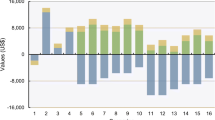Abstract
Environmental pollution analysis should be present in scientific research. The more organized the environmental laws of a particular place, the smaller the risks imputed to the ecosystem. The environmental damages that irregular waste from industrial effluents can cause are notorious. However, Brazil lacks extensive legal regulation, which is an embryonic legal matter. There is no specific law regulating a National Industrial Effluent Policy, dealing with the treatment and final disposal of these chemical compounds. Until a solid legal structure has been formalized on the treatment and final disposal of industrial effluents in Brazil, it is necessary that scientific researches optimize techniques capable of causing lower environmental impacts, so as to avoid possible pollution to the bodies of water. This article defends the argument that it is possible to elaborate legislation on the treatment and final disposal of industrial effluents in Brazil, through the application of engineering techniques, specifically through numerical simulation, by using the discrete elements method or particles method. The present case study is the Camaçari Petrochemical Pole, state of Bahia, which is the largest integrated industrial complex in the Southern Hemisphere, composed of more than 90 companies in the chemical and petrochemical areas. All the effluents from this locality are treated by CETREL (Liquid Effluent Treatment Plant). Particle analysis was performed in CETREL tanks to illustrate how numerical simulations can be applied to investigate the treatment of industrial effluents and, consequently, to affirm the importance of developing procedures and norms for this matter. It is believed that this article brings relevant information to support a future law that regulates a Brazilian National Policy of Industrial Effluents.






Similar content being viewed by others
References
Avci B, Wriggers P (2012) A DEM-FEM coupling approach for the direct numerical simulation of 3D particulate flows. J Appl Mech, vol. 79, pp. 010901-1-7
BAHIA, (2006) www.legislabahia.ba.gov.br. Available in: <http://www.legislabahia.ba.gov.br/verdoc.php?id=64087>. Access in: 30 Dez. 2016
BAHIA (2012) www.sucom.ba.gov.br. www.sucom.ba.gov.br. Available in: <http://www.sucom.ba.gov.br/wp-content/uploads/2015/04/Dec_Estadual_14024_2012.pdf>. Access in: 5 janeiro 2017. BAHIA. Decreto N.° 14.024, de 6 de junho de 2012. Aprova o Regulamento da Lei n° 10.431, de 20 de dezembro de 2006, que instituiu a Política de Meio Ambiente e de Proteção à Biodiversidade do Estado da Bahia, e da Lei n° 11.612 (.)
Batchelor W, Garnier G, O'Connor M (2014) Life cycle assessment comparison of industrial effluent management. Journal of Cleaner Production, Victoria, Australia, p. 168-181. Available in: <https://ac.els-cdn.com/S0959652614005435/1-s2.0-S0959652614005435-main.pdf?_tid=eb16f0c6-007a-11e8-92b1-00000aacb35f&acdnat=1516739037_da4bd54e20e5a2282bdfd791795a16f3>. Access in: 23 janeiro 2018
BRAZIL (1981) http://www.planalto.gov.br. http://www.planalto.gov.br. Available in: <http://www.planalto.gov.br/ccivil_03/LEIS/L6938compilada.htm>. Access in: 30 Dez. 2017
BRAZIL (1998). http://www.planalto.gov.br. http://www.planalto.gov.br. Available in: <http://www.planalto.gov.br/ccivil_03/leis/L9605.htm>
BRAZIL (2011a) http://www.mma.gov.br. http://www.mma.gov.br. Available in: <http://www.mma.gov.br/port/conama/legiabre.cfm?codlegi=646>. Access in: 26 Jan. 2018. Ministério do Meio Ambiente, Conselho Nacional de Meio Ambiente, CONAMA. Resolução CONAMA N.° 430, de 13 de maio de 2011
BRAZIL (2011b) http://www.planalto.gov.br. Http: //www.planalto.gov.br. Available in: <http://www.planalto.gov.br/ccivil_03/leis/LCP/Lcp140.htm>. Access in: 3 Jan. 2017. LEI COMPLEMENTAR N° 140, DE 8 DE DEZEMBRO DE 2011
Cheremisinoff NP (2003) www.sciencedirect.com. www.sciencedirect.com. Available in: <http://www.sciencedirect.com/science/article/pii/B9780750675079500036>. Access in: 6 janeiro 2014. Cheremisinoff, Nicholas P. Handbook of Solid Waste Management and Waste Minimization Technologies. Chapter 2 – Enviromental Laws and Regulatory Drivers.(2003). Disponível em: http://www.sciencedirect.com/science/article/pii/B9780750675079500036.
Cleary PW et al. (2011) Large scale simulation of industrial, engineering and geophysical flows using particle methods. In: Cleary P. W. et al. Particle-based methods. Fundamentals and applications. [S.l.]: Spring Netherlands, p. 89–111
COFIC (2018) http://www.coficpolo.com.br. http://www.coficpolo.com.br. Available in: <http://www.coficpolo.com.br/2009/ssma.php?cod=95&pagina=2>. Access in: 2 Jan. 2018. http://www.coficpolo.com.br
Huang J et al. (2014). A comprehensive eco-efficiency model and dynamics of regional eco-efficiency in China. Journal of Cleaner Production, China, v. 67, p. 228–238. Available in: <http://www.sciencedirect.com/science/article/pii/S0959652613008573>. Access in: 29 Dez. 2016
Johnson KL (2003) Contact mechanics. 9th. ed. Cambridge University Press, Cambridge
Kacianauskas R et al (2010) Parallel discrete element simulation of poly-dispersed granular material. Adv Eng Softw 41:52–63
Program TRI (2017) www.epa.gov. Available in: <https://www.epa.gov/toxics-release-inventory-tri-program/tri-listed-chemicals>. Access in: 08 janeiro 2018
Richardson DC et al (2011) Numerical simulations of granular dynamics: I. Hard-sphere discrete element method and tests. Icarus 212:427–437
SINIMA (2017) http://www.mma.gov.br. http://www.mma.gov.br. Available in: <http://www.mma.gov.br/governanca-ambiental/informacao-ambiental/sistema-nacional-de-informacao-sobre-meio-ambiente-sinima>. Access in: 3 Jan. 2017. SINIMA (Sistema Nacional de Informação sobre Meio Ambiente)
Zohdi TI (2003) Genetic design of solids possessing a random-particulate microstructure. The Royal Society
Zohdi TI (2007a) A computational framework for network modeling of fibrous biological tissue deformation and rupture. Comput Methods Appl Mech Eng 196:2972–2980
Zohdi TI (2007b) Computation of strongly coupled multifield interaction in particle-fluid systems. Comput Methods Appl Mech Eng 196:3927–3950
Zohdi TI (2007c) Particle collision and adhesion under the influence of near-fields. J Mech Mater Struct 2(6):1011–1018
Zohdi TI (2010a) High-speed impact of electromagnetically sensitive fabric and induced projectile spin. Comput Mech 46:399–415
Zohdi TI (2010b) Simulation of coupled microscalemultiphysicalfields in particulate-doped dielectrics with staggered adaptive FDTD. Comput Methods Appl Mech Eng 199:79–101
Zohdi TI (2014a) A direct particle-based computational framework for electrically-enhanced thermo-mechanical sintering of powdered materials. Math Mech Solids pp. 1-21
Zohdi TI (2014b) Additive particle deposition and selective laser processing-a computational manufacturing framework. Comput Mech 54:171–191
Acknowledgements
The authors would like to thank the CRML (Computational Materials Research Laboratory, University of California at Berkeley, USA).
The authors wish to express sincere appreciation to the independent public foundation Capes (Coordination of Improvement of Higher Level Personnel, Ministry of Education of Brazil), whose mission is to foster research and scientific and technological development.
Author information
Authors and Affiliations
Corresponding author
Additional information
Responsible editor: Philippe Garrigues
Rights and permissions
About this article
Cite this article
Bandeira, A.A., Esquerre, K.O., Bandeira, A.A. et al. Importance of legislation on the treatment of chemical effluents as a way to avoid environmental pollution: the use of numerical technique to simulate the sedimentation of chemical effluents. Environ Sci Pollut Res 26, 2547–2558 (2019). https://doi.org/10.1007/s11356-018-3713-4
Received:
Accepted:
Published:
Issue Date:
DOI: https://doi.org/10.1007/s11356-018-3713-4




